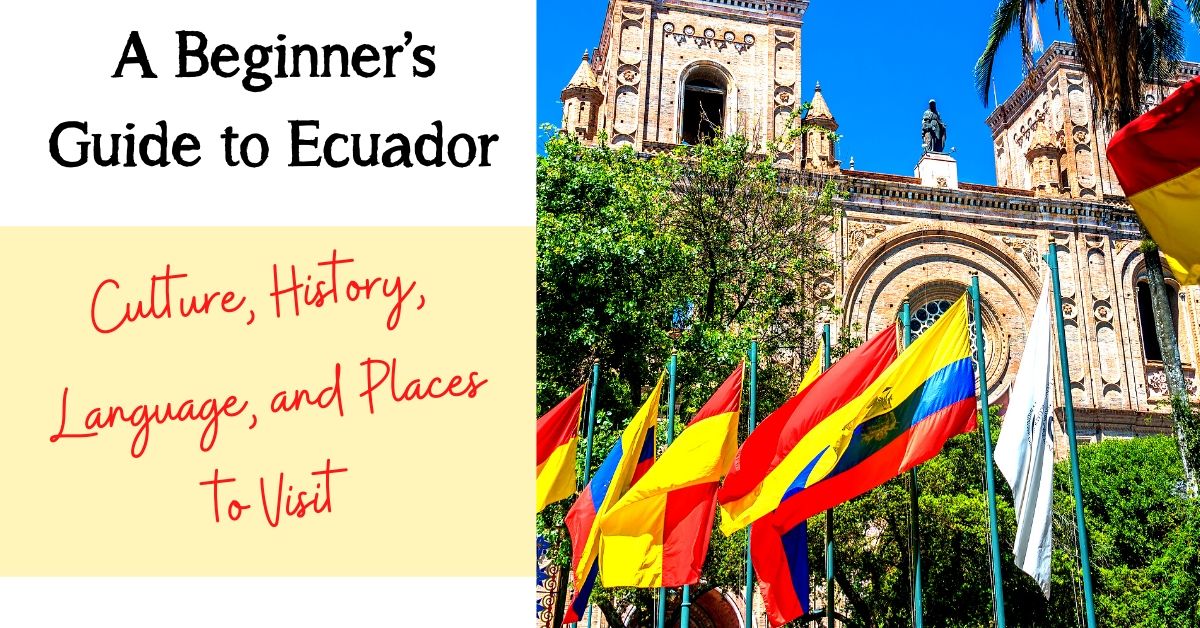
A Traveler’s Guide to Ecuador: Culture, History, and Language
Ecuador is tiny compared to most countries in South America, yet it’s one of the top 17 megadiverse countries worldwide. According to Lonely Planet, “a dazzling array of wonders is squeezed into this compact country.” Let’s delve into Ecuador’s fascinating history, culture, and language—and explore eight of its top attractions for travelers!
A Brief History of Ecuador
Tribes in northern Ecuador established the Kingdom of Quito in around 1000, and it eventually became part of the Inca Empire. After the arrival of Pizarro in 1532, the Spanish colony thrived for hundreds of years by exploiting the local population. Ecuador joined Venezuela, Colombia, and Panama in a union called Greater Colombia that lasted from 1819 to 1830.
Ecuador became an independent country in 1830. Conservatives ruled until an 1895 revolution led to several decades of radical liberal rule. Although it was under military law in the 1970s, Ecuador did not experience the repression of many other Latin American regimes. War with Peru has broken out periodically over the years, in 1941, 1981, and 1995. Finally, in May 1999, Ecuador and Peru signed a treaty ending the longtime border dispute.
Modern Ecuador
In 1998, the El Niño weather pattern caused Ecuador to experience one of its worst economic crises. The following year, the government was near bankruptcy, its sucre currency lost 40% of its value against the dollar, and the poverty rate rose to 70%. Ecuadorian president Jamil Mahuad was overthrown in January 2000. The junta gave power to the vice president, Gustavo Noboa, who restructured Ecuador’s foreign debt, adopted the U.S. dollar as the national currency, and continued privatization of industries—all the while generating a great deal of opposition.
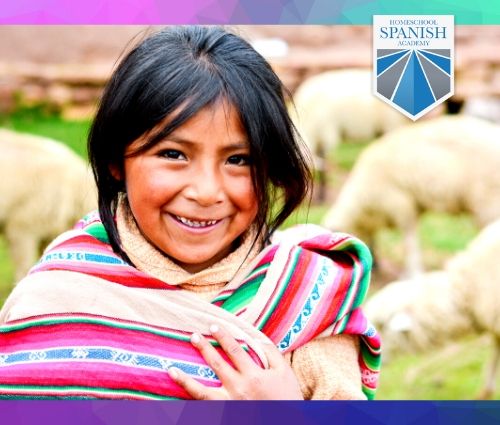
Within two years, Ecuador’s economy had rebounded from the brink of collapse, but corruption in the government has continued. In the 2006 presidential election, left-wing economist Rafael Correa won. Correa focused on boosting economic growth and rooting out corruption. In 2008, voters approved a new constitution that increased presidential powers and allowed Correa to run for two more consecutive terms. Correa won reelection in 2013 and left office in 2017. He fled to Europe and is now considered a fugitive by the Ecuadorian courts. He is wanted for the alleged kidnapping of an opposition lawmaker but cannot be tried in absentia on that charge.
Ecuadorian Culture 101
Ecuador’s culture is a mix of diverse traditions from the Andes, the Amazon, and the Pacific coast. As in all of Latin America, Spanish conquistadors forced Catholic traditions upon the Ecuadorian people, hence Catholicism is now ingrained in its national culture. About 40 to 65 percent of the population is mestizo, while roughly 25 percent of Ecuadorians are indigenous.
Indigenous Tribes of Ecuador
The Quichua (Kichwa) people live in the high Andes and make up the largest indigenous group in the country. Many still wear traditional dress, especially in small villages and such towns as Otavalo, Latacunga, and Saraguro. More than 1.5 million highland Quichua peoples speak Quichua as a first language.
The Awa live in the rainforests of northwestern Ecuador and adjacent Colombia. Modern-day Awa used to live on the coast but migrated inland to escape the Spanish colonists. There are around 8,000 Awa people in Ecuador and most still speak the Awapit language. Little is known about the Awa because they are reserved about their customs.
The Chachi (also known as the Cayapas) live along the Cayapas River in northwestern Ecuador and live in houses that are built on stilts. Some sell baskets and other handicrafts in Quito and Esmeraldas.
The Tsáchila indigenous group’s historic home of the Tsáchila is Santo Domingo in western Ecuador. About 2,000 of them still speak the Tsafiki language. Men wear black-and-white striped skirts, and women wear brightly colored striped skirts with .
Various groups live in the foothills and lowland rainforests of the Ecuadorian Amazon. Each group lives in a distinct area and speaks its own language. The Cofan culture has been affected by oil exploration and won a lawsuit against Texaco for contamination of their lands. The lowland Quichua live along the Napo River. The majority of the 4,000 Huaorani who live in the heart of the Ecuadorian Amazon welcome outsiders. They even have an eco-lodge on their lands where they teach Huaorani customs. Roughly 40,000 Shuar and 5,000 Achuar peoples live in the foothill rainforests of southern Ecuador and are related to indigenous groups in adjacent Peru.
Religion and Festivals
Mountains have great significance in traditional Ecuadorian faith. The largest mountains in a region are often called Taita, the Quechua word for father, and the second largest is Mama. Catholic shrines appear throughout the mountains wherever the conquistadors discovered Inca religious sites. Every native culture in Ecuador relies on healers for spiritual guidance and physical healing. They use medicinal plants like the coca leaf, quinine, tobacco, and ayahuasca.
The majority of Ecuadorians are Catholic and blend this religion with traditional and animist beliefs. They express their beliefs through dances, costumes, and animal sacrifice during parades and festivals.
Cuisine
Ecuadorian cuisine involves the dozens of colorful potato varieties harvested in the highlands. In the mountainous regions, people eat a lot of meat and thick stews; on the coast, lighter seafood and coconut dishes are the norm. Lunch and dinner will typically include fried or baked plantains, rice, yucca, and quinoa. Corn, beans, and hominy are also common side dishes. Ají peppers are always readily available, usually in the form of a bottled hot sauce.
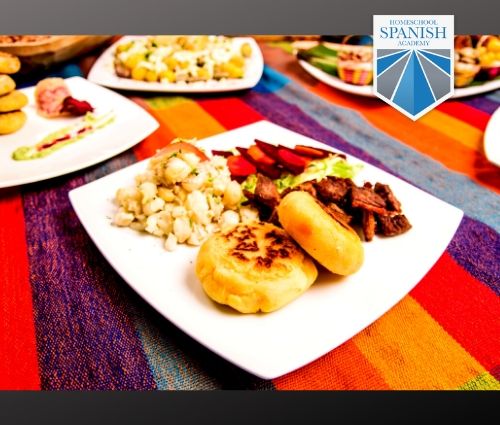
Popular Dishes
- Llapingachos: fried potato-and-cheese cakes, often served with meat, avocado, and a fried egg
- Salchipapas: fried sausages served with potatoes
- Cuy: the Quichua word for guinea pig; they are usually roasted and served whole
- Tallarines: vegetarian noodles dish
- Chaulafan: the Ecuadorian version of Chinese fried rice (Chowfa is the name for Ecuadorian-Chinese fusion food)
- Encocadas: white fish cooked in coconut milk, usually with peppers
- Bollos de pescado: a filet of fish steamed with peanuts inside a banana leaf
- Ceviches: white fish and shrimp marinated in citrus juice
- Locro de papa: a delicious potato, cheese, and avocado soup
Andean Music
One of the most well-known tunes of traditional Andean música folklórica (folk music) is Simon and Garfunkel’s version of “El Cóndor Pasa (If I Could).” This classic Andean tune was written by Peruvian composer Daniel Alomía Robles in 1913 well before the U.S. duo covered it.
Andean music typically features panpipes, which in Ecuador is known as the rondador, a single row of bamboo pipe that is considered Ecuador’s national instrument. Other traditional Andean instruments include the zampoña (two rows of cane pipes); quena and pingullo (large and small bamboo flutes); and charango, a mandolin-like instrument with 10 strings.
Ecuadorian Spanish
Spanish is Ecuador’s official language, while Quichua and Shuar are the two major indigenous languages. Quichua is the language of the Inca, and it is still used daily throughout the Sierra regions.
Slang
Here are some slang phrases that you can use to sound more like a local in Ecuador.
| Spanish | English | Example |
| Pilas | Look sharp | Mañana tenés que ganar, así que ¡pilas! You have to win tomorrow, so look sharp! |
| Chuta | Shoot (in soccer) | ¡El portero está distraído! ¡Chuta! ¡Chuta! The goalie is distracted! Shoot! Shoot! |
| ¿La plena? | Really/seriously? | ¡Quiero ir a la playa! – I want to go to the beach! ¿La plena? – Seriously? |
| Bacán | Cool | ¡Ese color es bacán! That color is cool! |
| Chévere | Cool | ¡Ese viaje va a estar chévere! That trip is going to be cool! |
| Cojudo | Stupid or silly person | ¡No seas cojudo! Don’t be stupid! |
| Que bestia | How crazy/that’s wild | ¡Que bestia! That’s crazy, man! |
| Chapa | Cop/police officer | ¡Me pararon los chapas por ir muy rápido! The police pulled me over because I was speeding! |
| Chumar | To drink liquor | Es muy joven para chumar. S/he is too young to drink. |
| Farra | Party | Maria estaba en la farra anoche. Maria was at the party last night. |
| Achachay | Cold | ¡Achachay! Pásame el abrigo. It’s cold! Give me the coat. |
| Amiguero/a | People person | Juana es muy amiguera. Juana is a people person |
| Chuchaqui | Hangover | Tengo un chuchaqui terrible. I have a terrible hangover. |
| Cholo/a | Tacky | ¡Que cholo eres! You’re so tacky! |
| Cachas | Catch/understand | ¿Cachas lo que te digo? Do you understand what I’m saying? |
| De ley | Of course | ¿Vas a la fiesta? – Are you going to the party?¡De ley! – Of course! |
| Ñaño/a | Brother/sister | No sé dónde está mi ñaño. I don’t know where my brother is. |
| Soroche | Altitude sickness | Ella tiene soroche. She has altitude sickness. |
| Jamear | To eat | Más tarde podemos irnos a jamear algo. We can go eat something later. |
| Charamitate | Personal belongings | Solo necesito recoger mis charamitates. I just need to pick up my stuff. |
8 Spectacular Sites to Visit in Ecuador
In Ecuador, you can step off the beaten path to explore beachside villages, visit ancient pyramids, and hike through mountains and rainforests. Pack a good-quality rain jacket due to the unpredictable weather in many regions!
1. The Galápagos Islands
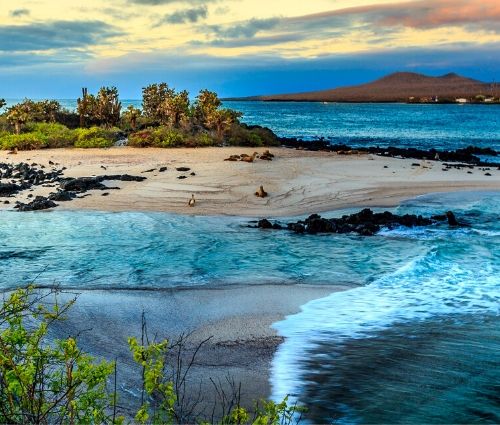
Ecuador’s most popular tourist site sits in the Pacific Ocean over 600 miles from the mainland. The archipelago consists of 19 islands. British biologist Charles Darwin famously visited in 1835 while developing his theory of natural selection. The marine wildlife reserve surrounding the Galapagos are a unique showcase of evolution. Because of seismic and volcanic activity and the extreme isolation of the islands, they are home to rare animals like the land iguana and giant tortoise.
2. Quito
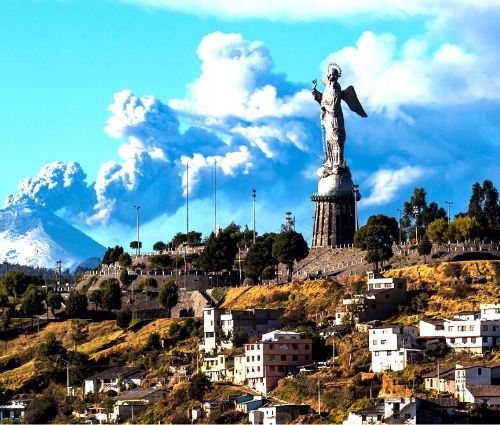
Ecuador’s historic Andean capital is perched in the Andes Mountains at the foot of the Pichincha volcano. Due to being one of the best-preserved colonial cores in Latin America, Quito became the first-ever UNESCO World Heritage site. It’s easy to get pleasantly lost in this quaint city’s narrow cobblestone streets, candlelit monasteries, and cozy plazas.
3. Cuenca
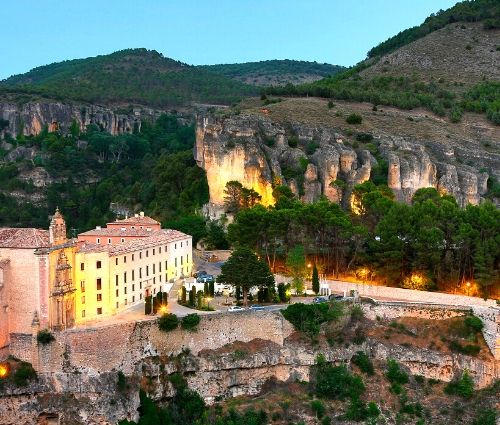
Cuenca is Ecuador’s third-largest city. Although it was founded as a Spanish settlement in the mid-1500s, traces of civilization there go as far back as 10,000 years. Santa Ana de los Cuatro Ríos de Cuenca is full of rivers, as well as Incan ruins that visitors can still see from right within the city today. Cuenca is also known as the “Athens of Ecuador” due to its European feel and centuries-old colonial architecture.
4. Cotopaxi National Park
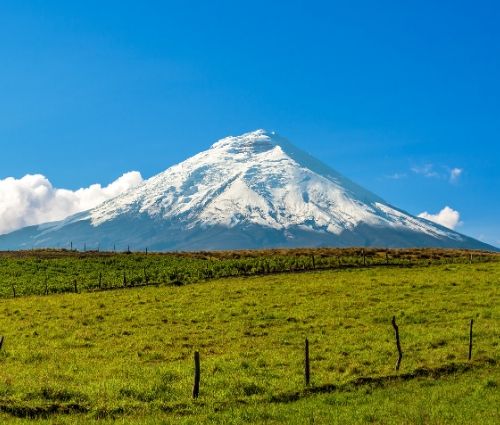
Featuring dazzling views of the páramo (alpine tundra) landscape, Cotopaxi National Park is Ecuador’s most popular mainland park. Its snow crested namesake, the Cotopaxi volcano, is the center of the attraction. The park is also home to the dormant Rumiñahui volcano and the historical Sincholagua volcano. Located 30 miles south of Quito, the Cotopaxi is among the highest active volcanoes in the world; its last significant eruption took place in 1904.
5. Guayaquil Boardwalk
Discover the charms of Ecuador’s largest city, Guayaquil. Renewal projects implemented throughout the city in recent years include upscale dining districts and sparkling waterfront promenades. Guayaquil boasts the largest ferris wheel in South America, a variety of entertainment complexes, and a renovated train line to the countryside. Established in 1538, some vivid architecture from centuries past can still be seen today while wandering around the steamy port town.
6. Otavalo Market
This small city in the Andes is home to South America’s largest market, famous for its textiles and handmade artisanal products. The Otavalo market features everything from dreamcatchers, hand-painted ceramics, and traditional nut jewelry to indigenous costumes, spices, and gorgeous textiles. Interestingly, Otavaleños make up only 50% of the town’s population; you’ll also find Kichwa peoples, Afro-Ecuadorians, and mestizos.
7. Amazon’s Upper Reaches in Tena
Tena is the quintessential jungle town, perfect for travelers seeking adventure by going on a trek, spelunking, or kayaking. Once an important colonial trading post in the Amazon, Tena is now the capital of the Napo Province. With a population of 13,000, this small town has retained its traditional culture and lifestyle. Many lowland Quichua Indians, Quijos, and Chibcha indigenous groups live in the forests outside Tena. You can go there to observe or take part in traditional dancing, chicha making (an alcoholic drink made by chewing maize, rice or yuca and fermenting the juice), and shamanic rituals.
8. Beaches of Tonsupa and Mompiche
Dotted with both small fishing villages and resort towns, the Pacific Coast of Ecuador is home to some of the most pristine beaches in South America. The beaches of the Esmeraldas province are among the most visited along the coast for their natural beauty and proximity to Quito. Tonsupa features wide beaches, cool water, and golden sand. Mompiche is a lovely fishing village with dark sand and a low-key, natural setting.
¿Vas a Ecuador?
Before you set out to explore the brilliant country of Ecuador, sign up for a free class to practice your Spanish. Our friendly teachers would love to help you prepare for a trip to Ecuador or any Spanish-speaking country in South America!
Want to learn more about Latin and South American culture? Check out these posts!
- Language Learning with Netflix: How to Use the Chrome Extension
- Earth Day Projects for Kids + Spanish Earth Day Vocabulary
- Turn Your Life Around: From Passive Bilingualism to Fluency!
- 23 Common Spanish Prepositions You Can Use Today
- 25 Common Subjunctive Phrases in Spanish Conversation
- 10 Homeschooling Styles You Need to Explore in 2023
- What Is an Infinitive in Spanish?
- Celebrating Culture and Joy: The Magic of Carnival in Spanish-Speaking Countries
- 10 Innovative Contemporary Latin American Artists Who Broke the Mold - February 16, 2023
- The Sweetest Guide to Valentine’s Day Vocabulary in Spanish - February 14, 2023
- 10 Famous Afro-Latinas Who’ve Made a Powerful Impact - February 9, 2023





